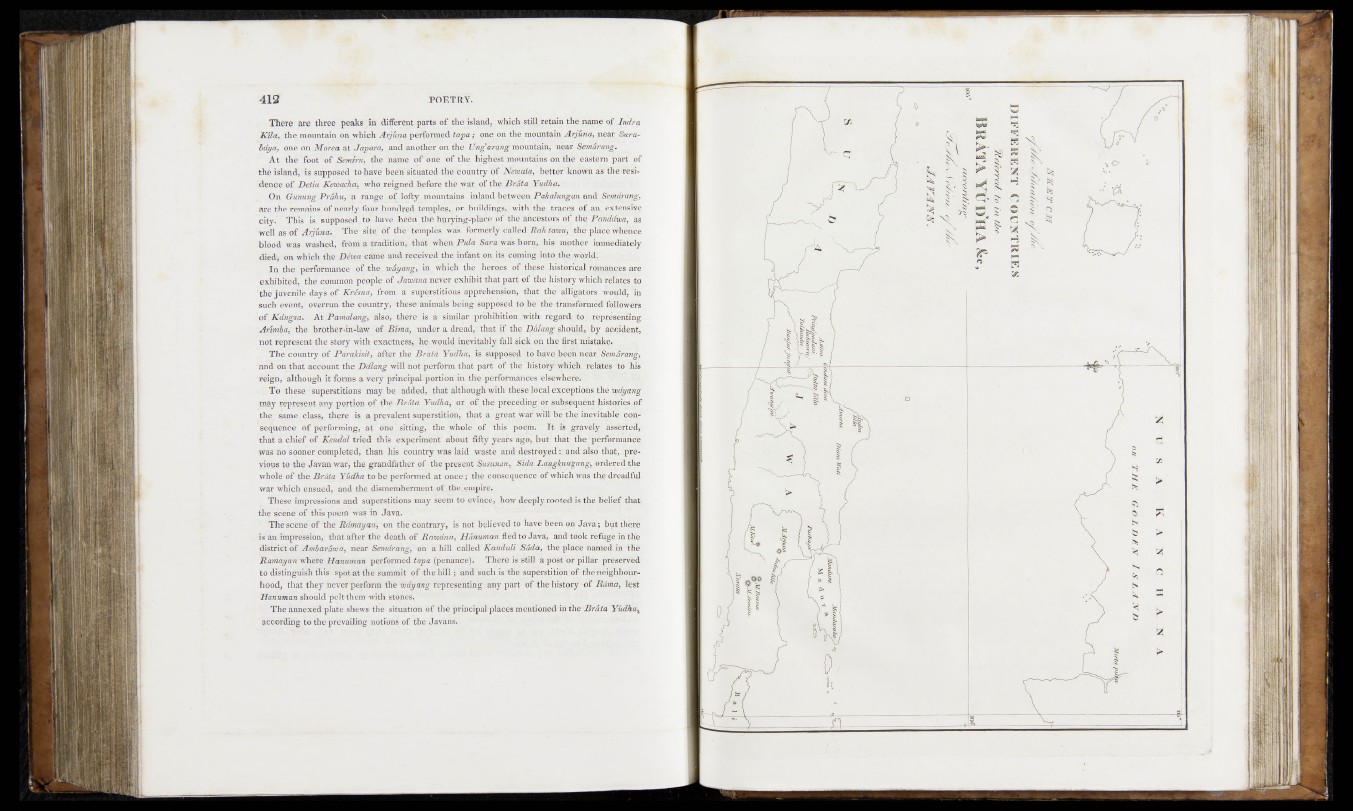
There are three peaks 'in different parts of the island, ; which, stil^-retain the naine of Indra
IsTfe,.:the.mountain on which Aijuna performed tapa ; one on the mowitain.Arjnna, near l$ura-
bdya, one on Morea at Jqpara,, .and another, on the Ung’arqng mountain, ijear Semljrang.
' At the' foot of" Semiru, the name of'one of the KigfrfeViiouritams on th|r éasfern part of
the island, is supppsed'tohave been situated the 'country ôf Wâtoaia,- better-'known as the’resi-
Idenpe of Detia Kevoacha, who reigned before the war of the Brdta. _
; ' On'&unung Prahu, ~a range , of lofty. mountains infand-h^jyeen. Rakakmgan and 'Seyidçang,
are the remains of .nearly fovi r hundred temples,, pr. hijildmgs,, with "the traces of ap,, extensive
city. * Tbts is supposai rtw have been the burying-place of the'all CCS tors of tn e jr ànddïvaj as
[well as of Aijuna. The site of thé-temples was. formerly called Rateteem.} t&epldcb wfiMlfe
blood was, washed, from-a -tfaditiob.;- that "when Pula Sdraiwas born,, his; mother immediately
die'd; on which the D ê i» a c^ne and recèiyed the infant on itSjCqnjing intOjtijegv^d.h d
In the p'erfdfmance of Xhe.wayangj in. which thçr(heroes of,these historical.Romances are
exhibited,, the common people, of Jrtwana neverej&ibitthat part of the history which relies" to
'the'juvèmle i&y&’pY jèdêindjïtôm a superstitiouséppfeherisio'nj that1 tBehaJ'hgaTOfS'^oKd^ni
such event, overrun the country, these animalsbeing'sdppesed to-be the fiânsforméd-'folltîwérs
of Kdngsa.. At Pamaltmg, also} there; is a similar (prj^bitipn.’with' rhgaydn,{o,h representing
Arvmba,’ the brother-in-law of, Pima, under a dread,'that if tfie Z)dZasg'sh<mH| 'by accjdenfc
npt. represent the story with exactness, 15e.would inevitablv. fall^lçk-onjQie Tjratpnistake.
The country of Parakisit, after jhe Brata Yu&naj is supposed to,have jbeen neai.Sepnârarrg,
'and on th a t account the Ddlang will hat.p‘erform that part of'trfe nrstcSy; which relates ‘to his
reign, although it forms a very pra«oi^-portiôn4iUth'mpeidormâ8cesl81S^ne?Hfir' *
To thèse superstitions maybe added, that although;with thespiiocaje^cepfcioi^!, the ’fgjyang
may represent any portion of ihe Breda. Yudha, «rl*f,the preceding,or..subsequent his£mihs*p£’
the same, class,, there, is a prevalent superstition, that a-.grëat. war^w&l 'fe^t^g^eyitabl'e.*:cdn.-
sequence of'perfb ming, at one sitting, 'the whole-rof' t h i s ' g r a v e r * asserted,
that à chief of Kendal tried this -experiment about fifty, thatwas
no sooner completed, than his conntr§!rwasiai.d. waste and destroyed : and also that, previous
to the Javan war, the grandfather ofhfbe'present StcsunahSSid^Limg^ngai^g,^ ordere d the
whotè.of the ;Bfi%t Yudha to be performed at ongfe-rthe consaqueppoftv«|mê^ the dreadful
war which ensued, and the dismemberment of tbe,gmpire.
These impressions and superstitions may seem to evince, haw .deeglyjiaof.ed.isftiei,belief that-
the scene of this poem- was in Java.
• "Thé scene of the Rdmayan, oâ^feè.fcôntrary, ft'noi bëlîévecf-tô have-b'èen dff'Java ; there
is ai^impression,' that after the death of Rdwdna, Hânuman fiai to Java, and fd'ok-^fefugëw'tlm''
district o f Ambarâwa, near Sèmdrang, on a hill called Kàhdali $&!<*,.‘the place named in •^Ke
Ramayan where Hanumcm performed topa fpenânce)-. There is--sfcill‘ a pdst’or pillar preserved
to distinguish this spot at the summit of the hiH ; ’and such‘is the superstition of thèidêi|hb'ouf-
hood,' that they,'iîever'>perform the tO^tmÿ’rèpfesénting'rany part of the history or RZtma, lest
Hanuman should pel'fftfrem'wifih'-étoneS. ' ' :
- The'æahexéd'plate shews-the situation of the principal places mentioned ih the Bràla Yûdh'a^
according to the prevailing notions of the Javans.